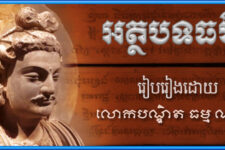THE PALI CANON What a Buddhist Must Know (5)
The significance of the Pali Canon
The significance of the Pali Canon in the maintenance of the Teaching can be appreciated more when the Pali Canon is seen in relation to other components of Buddhism.
—————————
The Pali Canon and the three true doctrines
From another perspective, what Buddhism is all about can be summarized in three words: Pariyatti, Paṭipatti, and Paṭivedha, or the three true doctrines.
Pariyatti refers to the word of the Buddha that we study, through the Pali Canon, without which the Buddha’s teachings could never reach us. We can say that the Pariyatti is the result of the Paṭivedha and is also the basis for the practice (Paṭipatti) of Buddhism.
After achieving the result of his own practice, the Buddha proclaimed the Teaching, based on his own experiences. The word of the Buddha thus became our Pariyatti, i.e. what we have to learn. However, when we regard the Pariyatti as the result of the Paṭivedha, we exclusively refer to the Paṭivedha of the Buddha, i.e. the result of his own practice and the result of the practice accepted by the Buddha, but not that of any yogi, hermit, ascetic, recluse, anchorite, preacher, cult leader, or founder of another religion.
Without learning the Pariyatti or what the Buddha taught, our practice would be misguided, mistaken, and deviant from the original Teaching. If our practice was wrong, whatever result we achieved could not be correct. And if we deceived ourselves with our own findings that were erroneously taken to be true, there could be no way for the Paṭivedha to ensue.
Hence, without the Pariyatti as basis, the Paṭipatti and the Paṭivedha would also fail to materialize. All would collapse together.
To put it simply, from the Buddha’s own Paṭivedha came our Pariyatti, which we learn and which provides the basis for our practice (Paṭipatti). When we practice properly, we will achieve the Paṭivedha just as the Buddha did. As long as this cycle still goes on, the Buddha’s Teaching will survive.
The Pariyatti that was derived from the Buddha’s Pṭivedha and provides the basis for all Buddhists to practice is to be found in the Pali Canon,
From this perspective, then, if we are to preserve the Pariyatti, Paṭipatti and Paṭivedha, we will have to preserve the Pali Canon.
Whether we trichotomize the Teaching into Pariyatti-saddhamma, Paṭipatti-saddhamma, and Paṭivedha-saddhamma (i.e. the three true doctrines), or sometimes dichotomize it into Pariyatti-sāsana and Paṭipatti-sāsana (i.e. the two dispensations), it all boils down to the Pali Canon as the basis. Thus if we can preserve the Canon, so can we preserve Buddhism.
Phra Brahmagunabhorn (P. A. Payutta)
Translated from Thai by Dr. Somseen Chanawangsa.
————————————
ព្រះត្រៃបិដក : គម្ពីរដែលពុទ្ធសាសនិកត្រូវតែដឹង(៥)
សេចក្ដីសំខាន់នៃព្រះត្រៃបិដក
សេចក្ដីសំខាន់នៃព្រះត្រៃបិដកចំពោះការថែរក្សាព្រះសាសនា អាចនឹងយល់បានរឹតតែច្បាស់ឡើង កាលបើយើងមើលឃើញសម្ពន្ធភាពរវាងព្រះត្រៃបិដកនិងចំណែកផ្សេងៗ របស់ព្រះពុទ្ធសាសនា ។
———————————
ព្រះត្រៃបិដកនិងព្រះសទ្ធម្ម ៣
មើលពីជ្រុងជ្រោយនៃទស្សនវិស័យមួយទៀត តួព្រះពុទ្ធសាសនាពិតប្រាកដអាចសង្ខេបបានជា ៣ ពាក្យដែលហៅថាសទ្ធម្ម ៣ គឺ បរិយត្តិ បដិបត្តិ និងបដិវេធ ។
បរិយត្តិសទ្ធម្មសំដៅដល់ព្រះពុទ្ធវចនៈដែលយើងសិក្សាក្នុងព្រះត្រៃបិដក បើប្រាសចាកព្រះត្រៃបិដក ព្រះពុទ្ធវចនៈក៏មិនអាចធ្លាក់មកដល់យើងឡើយ យើងអាចពោលបានថា បរិយត្តិជាផលដែលបានមកពីបដិវេធផង និងជាមូលដ្ឋានសម្រាប់ការបដិបត្តិក្នុងពុទ្ធសាសនាផង ។
ក្រោយពីបានសម្រេចផលនៃការបដិបត្តិ ព្រះពុទ្ធជាម្ចាស់ទ្រង់បាននាំបទពិសោធន៍ដែលជាផលនៃការបដិបត្តិរបស់ព្រះអង្គផ្ទាល់នោះ មកប្រៀនប្រដៅយើងគឺព្រះធម្មវិន័យ ។ ពាក្យប្រៀនប្រដៅនោះក្លាយមកជាបរិយត្តិរបស់យើង គឺរឿងដែលយើងត្រូវសិក្សាស្វែងយល់ ។ ប៉ុន្ដែបរិយត្តិដែលជាផលដែលបានមកពីបដិវេធនោះ បានដល់បដិវេធចំពោះរបស់ព្រះពុទ្ធជាម្ចាស់ គឺផលនៃការបដិបត្តិរបស់ព្រះពុទ្ធផ្ទាល់និងផលនៃការបដិបត្តិដែលព្រះពុទ្ធជាម្ចាស់ទទួលយកប៉ុណ្ណោះ មិនសំដៅយកផលនៃការបដិបត្តិរបស់យោគី ឥសី តាបស អ្នកបួស អ្នកព្រត អាចារ្យ មេលទ្ធិ ឬសាស្ដានៃសាសនាដទៃឡើយ ។
បើប្រាសចាកការសិក្សាបរិយត្តិធម៌ឬពាក្យប្រៀនប្រដៅរបស់ព្រះពុទ្ធជាម្ចាស់ ការបដិបត្តិរបស់យើងក៏នឹងឃ្វៀង ខុស ឃ្លាតចេញពីពាក្យប្រៀនប្រដៅដើម ។ បើការបដិបត្តិខុសហើយ ផលដែលបានទទួលក៏នឹងខុសដែរ ហើយបើបោកបញ្ឆោតខ្លួនឯងដោយការរកឃើញរបស់ខ្លួនដែលយើងយល់ខុសថាជាពិត បដិវេធក៏មិនអាចកើតឡើងបាន ។
ហេតុនេះ បើគ្មានបរិយត្តិជាមូលដ្ឋានទេ បដិបត្តិនិងបដិវេធក៏មិនអាចសម្រេចបាន ទាំងអស់នឹងសោះសូន្យជាមួយគ្នា ។
សរុបងាយៗថា ពីបដិវេធរបស់ព្រះពុទ្ធជាម្ចាស់ផ្ទាល់ មកជាបរិយត្តិរបស់យើង ដែលយើងសិក្សានិងបដិបត្តិតាមបរិយត្តិនោះ កាលបើបដិបត្តិត្រូវ ក៏នឹងចាក់ធ្លុះបដិវេធដូចព្រះពុទ្ធបានសម្រេច ដរាបណារង្វង់ចរន្ដនេះនៅប្រព្រឹត្តទៅ ព្រះពុទ្ធសាសនាក៏នឹងស្ថិតនៅ ។
បរិយត្តិធម៌ ដែលមកអំពីបដិវេធរបស់ព្រះពុទ្ធជាម្ចាស់ ព្រមទាំងជាមូលដ្ឋានសម្រាប់បដិបត្តិរបស់ពុទ្ធបរិស័ទទាំងឡាយនោះ មាននៅក្នុងព្រះត្រៃបិដក ។
សរុប មើលពីជ្រុងជ្រោយនៃទស្សនវិស័យនេះបានថា បើយើងនឹងថែរក្សាព្រះបរិយត្តិសទ្ធម្ម បដិបត្តិសទ្ធម្ម និងបដិវេធសទ្ធម្មឱ្យនៅគង់វង់ យើងត្រូវតែថែរក្សាព្រះត្រៃបិដកឱ្យ(បរិសុទ្ធ)គង់វង់ ។
មិនថាយើងចាត់រួមពាក្យប្រៀបប្រដៅទៅក្នុងព្រះបរិយត្តិសទ្ធម្ម បដិបត្តិសទ្ធម្ម និងបដិវេធសទ្ធម្ម ឬជួនកាលយើងបំបែកចេញជាបរិយត្តិសាសនា បដិបត្តិសាសនា និងបដិវេធសាសនាក៏តាម រួមសេចក្ដីក៏នៅត្រង់ព្រះត្រៃបិដកជាមូលដ្ឋាន បើយើងថែរក្សាព្រះត្រៃបិដកបាន ទើបរក្សាព្រះពុទ្ធសាសនាបាន ។
—————————-
សេចក្ដីប្រែជាខេមរភាសា គ្រាន់តែជាជំនួយសម្រាប់អ្នកដែលអានអង់គ្លេសមិនបានប៉ុណ្ណោះ ។
ដកស្រង់ពីៈ The Pali Canon: What a Buddhist Must Know.
By Ven. Bhikkhu P.A. Payutto
ប្រែសម្រួលអត្ថបទដោយ តាអារាមប៊យ
១៥ កក្កដា ២០១៨

